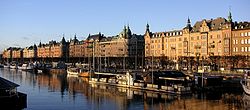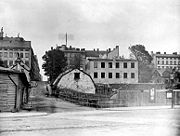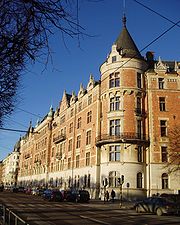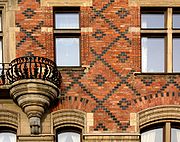
Strandvägen
Encyclopedia

Boulevard
A Boulevard is type of road, usually a wide, multi-lane arterial thoroughfare, divided with a median down the centre, and roadways along each side designed as slow travel and parking lanes and for bicycle and pedestrian usage, often with an above-average quality of landscaping and scenery...
on Östermalm in central Stockholm
Stockholm
Stockholm is the capital and the largest city of Sweden and constitutes the most populated urban area in Scandinavia. Stockholm is the most populous city in Sweden, with a population of 851,155 in the municipality , 1.37 million in the urban area , and around 2.1 million in the metropolitan area...
, Sweden
Sweden
Sweden , officially the Kingdom of Sweden , is a Nordic country on the Scandinavian Peninsula in Northern Europe. Sweden borders with Norway and Finland and is connected to Denmark by a bridge-tunnel across the Öresund....
. Completed just in time for the Stockholm World's Fair 1897
General Art and Industrial Exposition of Stockholm (1897)
The General Art and Industrial Exposition of Stockholm of 1897 also known as Stockholm Exhibition or Stockholm World's Fair was a World's Fair staged in 1897 in Stockholm, Sweden....
, it quickly became known as one of the most prestigious addresses in town.
Stretching 1 km (3.500 ft) east from Nybroplan
Nybroplan
Nybroplan is a public space in central Stockholm, Sweden. Located on the border between the city districts Norrmalm and Östermalm, Nybroplan connects a number of major streets, including Birger Jarlsgatan, Strandvägen, Hamngatan, and Nybrogatan...
, Strandvägen is intercepted by (west to east) Arsenalsgatan, Nybrogatan
Nybrogatan
Nybrogatan is a street in the borough of Östermalm in central Stockholm, Sweden. Approximately one kilometre in length, it stretches north from Nybroplan to Valhallavägen....
, Sibyllegatan, Artillerigatan
Artillerigatan
Artillerigatan is a street in the district of Östermalm in Stockholm, Sweden.- History :Artillerigatan was previously divided into three street sections; Löjtnantsgatan in the southern part , Artillerigatan and Kvarngatan to the north...
, Skeppargatan, Grevgatan, Styrmansgatan, Grev Magnigatan, Torstenssonsgatan
Torstenssonsgatan
Torstenssonsgatan, Östermalm, Stockholm, Sweden, stretches between Strandvägen and Storgatan. The street is crossed by Riddargatan. Torstenssonsgatan is a wide and short avenue with linden trees. In the extension of the street is The Museum of National Antiquities...
, Banérgatan, Narvavägen, Djurgårdsbron
Djurgårdsbron
Djurgårdsbron is a bridge in central Stockholm, Sweden. Designed by Carl Fraenell and built for the Stockholm World's Fair 1897, the present bridge forms a southern extension to the boulevard Narvavägen, thus connecting mainland Östermalm to the island Djurgården...
, Storgatan, Ulrikagatan, and Oxenstiernsgatan. It has four parallel streets: Almlöfsgatan, Väpnargatan, Kaptensgatan, and Riddargatan
Riddargatan
Riddargatan is a street in central Stockholm, the capital of Sweden....
. Hamngatan
Hamngatan
Hamngatan is a street in central Stockholm. It goes from Sergels torg down to Nybroplan, past NK department store, Kungsträdgården, Norrmalmstorg, and Berzelii Park. The Djurgården line travels along this street between Nybroplan and Norrmalmstorg....
forms a continuation in its western end, as do Djurgårdsbrunnsvägen in its eastern end.
The Djurgården heritage tramway
Djurgården line
Djurgårdslinjen is a heritage tramway with line number 7, running between Norrmalmstorg and Waldemarsudde in Stockholm, Sweden.-History:The line, along with almost every other tram line in Stockholm, was withdrawn in conjunction to the switch to right-hand side traffic in 1967, but was restored as...
passes over Strandvägen. The waters south of the street are named Nybroviken
Nybroviken
Nybroviken is a small bay in central Stockholm, Sweden.Nybroviken separates the city district Östermalm from the peninsula Blasieholmen. North of the bay is Berzelii Park and Norrmalmstorg. To the south Nybroviken connects to the bay Ladugårdslandsviken...
, Ladugårdslandsviken, and Djurgårdsbrunnsviken
Djurgårdsbrunnsviken
Djurgårdsbrunnsviken is a bay in central Stockholm, Sweden, together with the canal Djurgårdsbrunnskanalen forming the northern shore line of the island Djurgården...
.
History



Esplanade
An esplanade is a long, open, level area, usually next to a river or large body of water, where people may walk. The original meaning of esplanade was a large, open, level area outside fortress or city walls to provide clear fields of fire for the fortress' guns...
planted with trees — "a street unparalleled in Europe". Works were started in 1862, but by the mid 1870s walking along the water front was still practicable at best, as the area was still crowded with sheds and hovels. The first trees along the 79 m wide street were planted in 1879, and while construction work on the buildings along the street was started in the 1880s, three of four of the 24 buildings were built in the 1890s. However, in front of the World's Fair in 1897, the street was trafficable for both pedestrians and vehicles.
Bünsow House (Bünsowska huset) on number 29–33 constructed in 1886–88, set a standard, not only for the entire street but for architecture in Sweden during the 1890s. It is named after Friedrich Bünsow, who made a fortune on wood and also embellished central Sundsvall
Sundsvall
-External links:* - Official site from Nordisk Familjebok - Sundsvalls tourist information bureau. - The alternative guide to Sundsvall. - Blog with photos from Sundsvall....
with the same kind of luxurious architecture. His architectural contest for the site at Strandvägen was won by the young architect Isak Gustaf Clason
Isak Gustaf Clason
Isak Gustaf Clason was a Swedish architect.- Biography :Clason studied engineering and later architecture at the Institute of Technology in Stockholm, where he was a student of A. T. Gellerstedt, and later at the architectural school of the Academy of Arts, at the time headed by Fredrik Wilhelm...
who during the contest was studying Renaissance architecture
Renaissance architecture
Renaissance architecture is the architecture of the period between the early 15th and early 17th centuries in different regions of Europe, demonstrating a conscious revival and development of certain elements of ancient Greek and Roman thought and material culture. Stylistically, Renaissance...
in the Loire Valley
Loire Valley
The Loire Valley , spanning , is located in the middle stretch of the Loire River in central France. Its area comprises approximately . It is referred to as the Cradle of the French Language, and the Garden of France due to the abundance of vineyards, fruit orchards, and artichoke, asparagus, and...
. From there he imported the towers, the dormers, and the "honest materials" (i.e. exposed bricks instead of plaster which dominated Swedish architecture during the preceding decades). In his 1895 novel Förvillelser, author Hjalmar Söderberg
Hjalmar Söderberg
Hjalmar Emil Fredrik Söderberg was a Swedish novelist, playwright, poet and journalist. His works often deal with melancholy and lovelorn characters, and offer a rich portrayal of contemporary Stockholm through the eyes of the flaneur...
described the building as "a defiant and brilliant knight's poem in stone".
Even though Bünsow House set the standard for the street, it was an exception in that it was commissioned by one of the prospected residents. The builders of the remaining buildings on Strandvägen were well aware of the value of the prestigious location, and therefore commissioned some of the best architects of the era to design both the façades and the 5–10 room apartments to appeal to their exclusive audience. From the beginning, the rental cost for most of the apartments behind the prestigious façades exceeded average salaries. The smaller apartments on the backyards, however, were intended for low-income earners.
Since 2005 works to develop Strandvägen into a more attractive area for both pedestrians and ships have been progressing: Footways are being paved in granite
Granite
Granite is a common and widely occurring type of intrusive, felsic, igneous rock. Granite usually has a medium- to coarse-grained texture. Occasionally some individual crystals are larger than the groundmass, in which case the texture is known as porphyritic. A granitic rock with a porphyritic...
and lampposts, benches, and litter bins are given a uniform design, while parked cars are confined to available underground carparks.

